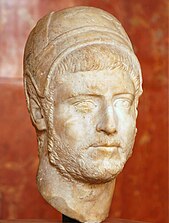
Back هيئة الأحبار Arabic Калегія пантыфікаў BE Col·legi dels Pontífexs Catalan Pontifex Czech Pontifikalkollegiet Danish Σύλλογος Ποντιφικών Greek Colegio de pontífices Spanish کولگیوم پونتیفکس FA Collège des pontifes French פונטיפקס HE
| Part of a series on the |
| Priesthoods of ancient Rome |
|---|
 |
| Major colleges |
| Other colleges or sodalities |
| Priests |
| Priestesses |
| Related topics |
The College of Pontiffs (Latin: Collegium Pontificum; see collegium) was a body of the ancient Roman state whose members were the highest-ranking priests of the state religion. The college consisted of the pontifex maximus and the other pontifices, the rex sacrorum, the fifteen flamens, and the Vestals.[1] The College of Pontiffs was one of the four major priestly colleges; originally their responsibility was limited to supervising both public and private sacrifices, but as time passed their responsibilities increased.[2] The other colleges were the augures (who read omens), the quindecimviri sacris faciundis ("fifteen men who carry out the rites"), and the epulones (who set up feasts at festivals).
The title pontifex comes from the Latin for "bridge builder", a possible allusion to a very early role in placating the gods and spirits associated with the Tiber River, for instance.[3] Also, Varro cites this position as meaning "able to do".[4]
The pontifex maximus was the most important member of the college. Until 104 BC, the pontifex maximus held the sole power in appointing members to the other priesthoods in the college.
The flamens were priests in charge of fifteen official cults of Roman religion, each assigned to a particular god. The three major flamens (flamines maiores) were the flamen Dialis, the high priest of Jupiter; the flamen Martialis, who cultivated Mars; and the flamen Quirinalis, devoted to Quirinus. The deities cultivated by the twelve flamines minores were Carmenta, Ceres, Falacer, Flora, Furrina, Palatua, Pomona, Portunus, Volcanus (Vulcan), Volturnus, and two whose names are lost.
The Vestal Virgins were the only female members of the college. They were in charge of guarding Rome's sacred hearth, keeping the flame burning inside the Temple of Vesta. Around age 6 to 10, girls were chosen for this position and were required to perform the rites and obligations for 30 years, including remaining chaste.
- ^ Jörg Rüpke, "Communicating with the Gods," in A Companion to Roman Religion, (Blackwell, 2010), p. 226; John A. North, "The Constitution of the Roman Republic," in the same volume, p. 268 (a table showing priestly roles of Roman religion, including assignment to colleges).
- ^ Martha W. Hoffman Lewis, The Official Priests of Rome under the Julio-Claudians (Rome: American Academy, 1955), p. 7
- ^ "Internet History Sourcebooks". fordham.edu.
- ^ Beard, Mary; North, John; Price, Simon (June 28, 1998). Religions of Rome: Volume 2, A Sourcebook. Cambridge University Press – via Google Books.